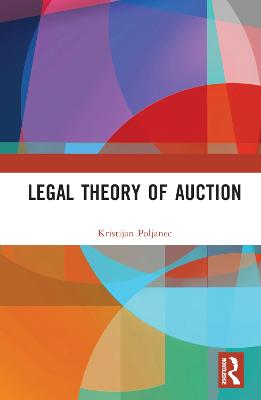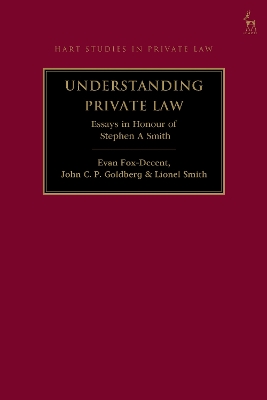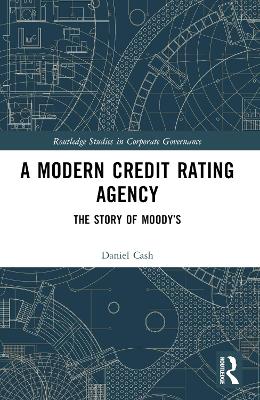Legal Theory of Auction
 portes grátis
portes grátis
Legal Theory of Auction
Poljanec, Kristijan
Taylor & Francis Ltd
09/2022
224
Dura
Inglês
9781032079196
15 a 20 dias
616
Descrição não disponível.
Preface
List of acronyms
Table of cases
Table of legislation
Introduction
Price-determination methods
Brief note on the auction history
The rationale for this book
About the comparative legal method adopted in this book
Lack of comparative researches
Local character of auction sales
Self-regulatory character of auction rules
Fragmentary character of auction law
The comparative method
The objectives of the comparison
Contents of this book and the problems covered
Defining the legal concept of auction
Defining the structure of auction relationships
Defining the legal concept of internet auction
Filling the gaps in the EU resale right regime
Defining the legal nature of auction guarantees and the influence thereof on the position of the auctioneer
Finding a demarcation line between licit and illicit priceinfluencing tactics at auction
1 Legal concept of auction
Introduction
Economic concept of auction
Models
One-sided and double-sided auctions
Private value and common value auctions
Open-bid auctions and sealed-bid auctions
Revenue equivalence theorem
The theorem
The critics of the theorem
Legal concept of auction
Typical models
Ascending (English) auction
Features
Public and private auctions
Written and oral auctions
Absentee bids
Limited and unlimited absentee bids
Descending (Dutch) auction
Features
Subcategories
Is Dutch auction an auction at all?
Auction and auction-like bidding mechanisms
Games of chance and auctions
'Controlled' uncertainty
No risk of losing the stake
Purpose
Competitive bidding
Public procurement and auction
Stock exchange and auction
Auction and the public promise of a reward
Interim conclusion
2 Auction relationships
Introduction
Auction participants
Seller
Auctioneer
The notion
Consigned and property auction
Bidders
Objects
Legal relationships at English auction
Consignment agreement
Continental law
Intermediation
Representation
Direct representation
Indirect representation
Auctioneer acting as sole contractor
Ambiguities concerning representation
Rights and duties of the auctioneer
Fiduciary duties of the auctioneer
Personal engagement in carrying out the mandate
Avoidance of conflict of interest
Adherence to the consignor's instructions
Receipt of the price
Rights
Brokerage fee
Damages
Advances
Anglo-American law
Agency
Rights and duties of the auctioneer
The authority of the auctioneer
Fiduciary duty
Personal engagement of the auctioneer
Receipt of the price
Rights
Brokerage fee
Indemnities
Relationship between the auctioneer and the bidders
Continental law
Anglo-American law
The relationships between the bidders
Contract of sale
Continental law
Theory of invitation
The existence of an offer
The effect of the last (in)valid bid for previous bids
Higher bid
Duration of a bid
Notification of the knock-down
Auction sale with a 'retention of higher offer' clause (in diem addictio)
Legal implications of the auction sale
Transfer of risks and conveyance of property
The reserve price
Anglo-American law
Sale with reserve
Conditional auction
Sale without reserve (absolute auction sale)
Sale without restrictions
Transfer of risks and conveyance of property
Legal relationships (Dutch auction)
Interim conclusion
3 Internet auction
Introduction
The legal concept of internet auction
Internet auction and other distance sales
Auction models
English (ascending) and Dutch (descending) auction
Sealed-bid auctions
Live auctions and combined internet auctions
Business-to-consumer auction
Consumer-to-consumer auction
Business-to-business auction
Business-to-administration (business-to-government) auction
Government-to-consumer auction
Proprietary and intermediary auctions
User-to-customer and auctioneer-to-customer auctions
'Pay-to-sell' and 'pay-to-buy' auctions
Differences between internet and physical auction
Auction platform as a neutral intermediary
Auction platform as an auctioneer
The agency character of an auction platform
Virtual knock-down: functional equivalent to the traditional fall of the hammer
Closing remarks
Disadvantages of internet auctioneering
Anonymity
Risks of mistakes
Security risks
Delocalisation of auction sale and the problem of applicable law
The Rome I Regulation
The general regime for (internet) auction sales
Special regime for consumer (internet) auctions
The jurisdiction: principle of forum loci acti
Platform's immunity from liability
Legal relationships
User framework agreements
Individual user agreements
Seller-auctioneer relationship
Bidder-auctioneer relationship
Contract for sale
Interim conclusion
4 Auction and the EU artist's resale right
Introduction
Origins of the resale right
Civil-law and common-law views on the resale right
Civil law
Moral grounds for the introduction of the resale right
Need to fight social inequalities
Common law
Utilitarian theory of copyright
Free alienation of personal property
EU Resale Right Directive
The legislative history
Scope of application of the EU resale right
Notion and legal nature of the resale right
Transactions subject to resale right
Professional art sales
Is an internet auctioneer an 'art market professional'?
Sales exempted from the resale right
Persons liable for payment
Seller's liability -the principal model
Alternative liability regimes
The auctioneer's liability for payment of royalty
Circumvention of strictness of liability rules via indirect representation
The 'passing-on' of the royalty
Works covered by the resale right
Claim for payment of royalty
The establishment of the royalty claim
Basis for calculation
Deduction of auctioneer's fees from the calculation basis?
Calculation, collection and management of the royalty
Persons entitled to royalty
Disclosure requirements
Interim conclusion
5 Auction guarantees
Introduction
Auction guarantees
Types of auction guarantees
In-house guarantees
Third-party guarantees
Irrevocable bid (stand-by guarantee)
Legal nature of auction guarantees
Auction guarantee and unilateral promise to buy
Auction guarantee and 'restitute or buy' contract
Conditional private-treaty sale
Auction guarantees at continental auction sales
Impact of the auction guarantees on the art market
Auction guarantees meet critics
Economic advantages of auction guarantees
Reforming the auction guarantees
Collective funding campaigns: alternative to auction guarantees?
Interim conclusion
6 Price-influencing tactics
Introduction
Sham bidding
Civil-law aspects
Continental law
Knock-down to the best bidder
Annulment
Convalidation
Knock-down to the seller or puffer
Anglo-American law
Knock-down to the best bidder
Annulment
Convalidation
Punitive damages
Knock-down to the seller or puffer
Competition-law aspects
Continental law
Person entitled to seek damages
Person liable for damages
Scope of damages
Anglo-American law
Proving causation and measure of damage in antitrust cases
Abstention agreements ('bid-rigging')
Abstention from bidding for the benefit of a single bidder (pactum de non licitando)
Civil-law aspects
Continental law
Annulment of the sale
Convalidation
Anglo-American law
Annulment of the sale
Convalidation
Competition-law aspects
Continental law
Anglo-American law
Bid-rigging for the joint account of several bidders ('auction rings')
Damages under civil law
Damages under competition law
Bona fide partnership for the joint account of bidders (buyers' consortium, Bietergemeinschaft, Einkaufsgemeinschaft, convention d'association)
Interim conclusion
Conclusion
Bibliography
Index
List of acronyms
Table of cases
Table of legislation
Introduction
Price-determination methods
Brief note on the auction history
The rationale for this book
About the comparative legal method adopted in this book
Lack of comparative researches
Local character of auction sales
Self-regulatory character of auction rules
Fragmentary character of auction law
The comparative method
The objectives of the comparison
Contents of this book and the problems covered
Defining the legal concept of auction
Defining the structure of auction relationships
Defining the legal concept of internet auction
Filling the gaps in the EU resale right regime
Defining the legal nature of auction guarantees and the influence thereof on the position of the auctioneer
Finding a demarcation line between licit and illicit priceinfluencing tactics at auction
1 Legal concept of auction
Introduction
Economic concept of auction
Models
One-sided and double-sided auctions
Private value and common value auctions
Open-bid auctions and sealed-bid auctions
Revenue equivalence theorem
The theorem
The critics of the theorem
Legal concept of auction
Typical models
Ascending (English) auction
Features
Public and private auctions
Written and oral auctions
Absentee bids
Limited and unlimited absentee bids
Descending (Dutch) auction
Features
Subcategories
Is Dutch auction an auction at all?
Auction and auction-like bidding mechanisms
Games of chance and auctions
'Controlled' uncertainty
No risk of losing the stake
Purpose
Competitive bidding
Public procurement and auction
Stock exchange and auction
Auction and the public promise of a reward
Interim conclusion
2 Auction relationships
Introduction
Auction participants
Seller
Auctioneer
The notion
Consigned and property auction
Bidders
Objects
Legal relationships at English auction
Consignment agreement
Continental law
Intermediation
Representation
Direct representation
Indirect representation
Auctioneer acting as sole contractor
Ambiguities concerning representation
Rights and duties of the auctioneer
Fiduciary duties of the auctioneer
Personal engagement in carrying out the mandate
Avoidance of conflict of interest
Adherence to the consignor's instructions
Receipt of the price
Rights
Brokerage fee
Damages
Advances
Anglo-American law
Agency
Rights and duties of the auctioneer
The authority of the auctioneer
Fiduciary duty
Personal engagement of the auctioneer
Receipt of the price
Rights
Brokerage fee
Indemnities
Relationship between the auctioneer and the bidders
Continental law
Anglo-American law
The relationships between the bidders
Contract of sale
Continental law
Theory of invitation
The existence of an offer
The effect of the last (in)valid bid for previous bids
Higher bid
Duration of a bid
Notification of the knock-down
Auction sale with a 'retention of higher offer' clause (in diem addictio)
Legal implications of the auction sale
Transfer of risks and conveyance of property
The reserve price
Anglo-American law
Sale with reserve
Conditional auction
Sale without reserve (absolute auction sale)
Sale without restrictions
Transfer of risks and conveyance of property
Legal relationships (Dutch auction)
Interim conclusion
3 Internet auction
Introduction
The legal concept of internet auction
Internet auction and other distance sales
Auction models
English (ascending) and Dutch (descending) auction
Sealed-bid auctions
Live auctions and combined internet auctions
Business-to-consumer auction
Consumer-to-consumer auction
Business-to-business auction
Business-to-administration (business-to-government) auction
Government-to-consumer auction
Proprietary and intermediary auctions
User-to-customer and auctioneer-to-customer auctions
'Pay-to-sell' and 'pay-to-buy' auctions
Differences between internet and physical auction
Auction platform as a neutral intermediary
Auction platform as an auctioneer
The agency character of an auction platform
Virtual knock-down: functional equivalent to the traditional fall of the hammer
Closing remarks
Disadvantages of internet auctioneering
Anonymity
Risks of mistakes
Security risks
Delocalisation of auction sale and the problem of applicable law
The Rome I Regulation
The general regime for (internet) auction sales
Special regime for consumer (internet) auctions
The jurisdiction: principle of forum loci acti
Platform's immunity from liability
Legal relationships
User framework agreements
Individual user agreements
Seller-auctioneer relationship
Bidder-auctioneer relationship
Contract for sale
Interim conclusion
4 Auction and the EU artist's resale right
Introduction
Origins of the resale right
Civil-law and common-law views on the resale right
Civil law
Moral grounds for the introduction of the resale right
Need to fight social inequalities
Common law
Utilitarian theory of copyright
Free alienation of personal property
EU Resale Right Directive
The legislative history
Scope of application of the EU resale right
Notion and legal nature of the resale right
Transactions subject to resale right
Professional art sales
Is an internet auctioneer an 'art market professional'?
Sales exempted from the resale right
Persons liable for payment
Seller's liability -the principal model
Alternative liability regimes
The auctioneer's liability for payment of royalty
Circumvention of strictness of liability rules via indirect representation
The 'passing-on' of the royalty
Works covered by the resale right
Claim for payment of royalty
The establishment of the royalty claim
Basis for calculation
Deduction of auctioneer's fees from the calculation basis?
Calculation, collection and management of the royalty
Persons entitled to royalty
Disclosure requirements
Interim conclusion
5 Auction guarantees
Introduction
Auction guarantees
Types of auction guarantees
In-house guarantees
Third-party guarantees
Irrevocable bid (stand-by guarantee)
Legal nature of auction guarantees
Auction guarantee and unilateral promise to buy
Auction guarantee and 'restitute or buy' contract
Conditional private-treaty sale
Auction guarantees at continental auction sales
Impact of the auction guarantees on the art market
Auction guarantees meet critics
Economic advantages of auction guarantees
Reforming the auction guarantees
Collective funding campaigns: alternative to auction guarantees?
Interim conclusion
6 Price-influencing tactics
Introduction
Sham bidding
Civil-law aspects
Continental law
Knock-down to the best bidder
Annulment
Convalidation
Knock-down to the seller or puffer
Anglo-American law
Knock-down to the best bidder
Annulment
Convalidation
Punitive damages
Knock-down to the seller or puffer
Competition-law aspects
Continental law
Person entitled to seek damages
Person liable for damages
Scope of damages
Anglo-American law
Proving causation and measure of damage in antitrust cases
Abstention agreements ('bid-rigging')
Abstention from bidding for the benefit of a single bidder (pactum de non licitando)
Civil-law aspects
Continental law
Annulment of the sale
Convalidation
Anglo-American law
Annulment of the sale
Convalidation
Competition-law aspects
Continental law
Anglo-American law
Bid-rigging for the joint account of several bidders ('auction rings')
Damages under civil law
Damages under competition law
Bona fide partnership for the joint account of bidders (buyers' consortium, Bietergemeinschaft, Einkaufsgemeinschaft, convention d'association)
Interim conclusion
Conclusion
Bibliography
Index
Este título pertence ao(s) assunto(s) indicados(s). Para ver outros títulos clique no assunto desejado.
Auction Sale;Reserve Price;Internet Auction;Buyer's Premium;Auction Laws;Auction Contract;Dutch Auction;Consignment Agreement;Lex Loci Acti;Hammer Price;Resale Royalty;Habitual Residence;English Auction;Auction Models;Auction House;Demarcation Line;Sale Contract;Statutory Interests;Basic Legal Relationships;Major Auction Houses;Brokerage Contract;Private Auctions;Private Treaty Sale;EU Secondary Law;Vice Versa
Preface
List of acronyms
Table of cases
Table of legislation
Introduction
Price-determination methods
Brief note on the auction history
The rationale for this book
About the comparative legal method adopted in this book
Lack of comparative researches
Local character of auction sales
Self-regulatory character of auction rules
Fragmentary character of auction law
The comparative method
The objectives of the comparison
Contents of this book and the problems covered
Defining the legal concept of auction
Defining the structure of auction relationships
Defining the legal concept of internet auction
Filling the gaps in the EU resale right regime
Defining the legal nature of auction guarantees and the influence thereof on the position of the auctioneer
Finding a demarcation line between licit and illicit priceinfluencing tactics at auction
1 Legal concept of auction
Introduction
Economic concept of auction
Models
One-sided and double-sided auctions
Private value and common value auctions
Open-bid auctions and sealed-bid auctions
Revenue equivalence theorem
The theorem
The critics of the theorem
Legal concept of auction
Typical models
Ascending (English) auction
Features
Public and private auctions
Written and oral auctions
Absentee bids
Limited and unlimited absentee bids
Descending (Dutch) auction
Features
Subcategories
Is Dutch auction an auction at all?
Auction and auction-like bidding mechanisms
Games of chance and auctions
'Controlled' uncertainty
No risk of losing the stake
Purpose
Competitive bidding
Public procurement and auction
Stock exchange and auction
Auction and the public promise of a reward
Interim conclusion
2 Auction relationships
Introduction
Auction participants
Seller
Auctioneer
The notion
Consigned and property auction
Bidders
Objects
Legal relationships at English auction
Consignment agreement
Continental law
Intermediation
Representation
Direct representation
Indirect representation
Auctioneer acting as sole contractor
Ambiguities concerning representation
Rights and duties of the auctioneer
Fiduciary duties of the auctioneer
Personal engagement in carrying out the mandate
Avoidance of conflict of interest
Adherence to the consignor's instructions
Receipt of the price
Rights
Brokerage fee
Damages
Advances
Anglo-American law
Agency
Rights and duties of the auctioneer
The authority of the auctioneer
Fiduciary duty
Personal engagement of the auctioneer
Receipt of the price
Rights
Brokerage fee
Indemnities
Relationship between the auctioneer and the bidders
Continental law
Anglo-American law
The relationships between the bidders
Contract of sale
Continental law
Theory of invitation
The existence of an offer
The effect of the last (in)valid bid for previous bids
Higher bid
Duration of a bid
Notification of the knock-down
Auction sale with a 'retention of higher offer' clause (in diem addictio)
Legal implications of the auction sale
Transfer of risks and conveyance of property
The reserve price
Anglo-American law
Sale with reserve
Conditional auction
Sale without reserve (absolute auction sale)
Sale without restrictions
Transfer of risks and conveyance of property
Legal relationships (Dutch auction)
Interim conclusion
3 Internet auction
Introduction
The legal concept of internet auction
Internet auction and other distance sales
Auction models
English (ascending) and Dutch (descending) auction
Sealed-bid auctions
Live auctions and combined internet auctions
Business-to-consumer auction
Consumer-to-consumer auction
Business-to-business auction
Business-to-administration (business-to-government) auction
Government-to-consumer auction
Proprietary and intermediary auctions
User-to-customer and auctioneer-to-customer auctions
'Pay-to-sell' and 'pay-to-buy' auctions
Differences between internet and physical auction
Auction platform as a neutral intermediary
Auction platform as an auctioneer
The agency character of an auction platform
Virtual knock-down: functional equivalent to the traditional fall of the hammer
Closing remarks
Disadvantages of internet auctioneering
Anonymity
Risks of mistakes
Security risks
Delocalisation of auction sale and the problem of applicable law
The Rome I Regulation
The general regime for (internet) auction sales
Special regime for consumer (internet) auctions
The jurisdiction: principle of forum loci acti
Platform's immunity from liability
Legal relationships
User framework agreements
Individual user agreements
Seller-auctioneer relationship
Bidder-auctioneer relationship
Contract for sale
Interim conclusion
4 Auction and the EU artist's resale right
Introduction
Origins of the resale right
Civil-law and common-law views on the resale right
Civil law
Moral grounds for the introduction of the resale right
Need to fight social inequalities
Common law
Utilitarian theory of copyright
Free alienation of personal property
EU Resale Right Directive
The legislative history
Scope of application of the EU resale right
Notion and legal nature of the resale right
Transactions subject to resale right
Professional art sales
Is an internet auctioneer an 'art market professional'?
Sales exempted from the resale right
Persons liable for payment
Seller's liability -the principal model
Alternative liability regimes
The auctioneer's liability for payment of royalty
Circumvention of strictness of liability rules via indirect representation
The 'passing-on' of the royalty
Works covered by the resale right
Claim for payment of royalty
The establishment of the royalty claim
Basis for calculation
Deduction of auctioneer's fees from the calculation basis?
Calculation, collection and management of the royalty
Persons entitled to royalty
Disclosure requirements
Interim conclusion
5 Auction guarantees
Introduction
Auction guarantees
Types of auction guarantees
In-house guarantees
Third-party guarantees
Irrevocable bid (stand-by guarantee)
Legal nature of auction guarantees
Auction guarantee and unilateral promise to buy
Auction guarantee and 'restitute or buy' contract
Conditional private-treaty sale
Auction guarantees at continental auction sales
Impact of the auction guarantees on the art market
Auction guarantees meet critics
Economic advantages of auction guarantees
Reforming the auction guarantees
Collective funding campaigns: alternative to auction guarantees?
Interim conclusion
6 Price-influencing tactics
Introduction
Sham bidding
Civil-law aspects
Continental law
Knock-down to the best bidder
Annulment
Convalidation
Knock-down to the seller or puffer
Anglo-American law
Knock-down to the best bidder
Annulment
Convalidation
Punitive damages
Knock-down to the seller or puffer
Competition-law aspects
Continental law
Person entitled to seek damages
Person liable for damages
Scope of damages
Anglo-American law
Proving causation and measure of damage in antitrust cases
Abstention agreements ('bid-rigging')
Abstention from bidding for the benefit of a single bidder (pactum de non licitando)
Civil-law aspects
Continental law
Annulment of the sale
Convalidation
Anglo-American law
Annulment of the sale
Convalidation
Competition-law aspects
Continental law
Anglo-American law
Bid-rigging for the joint account of several bidders ('auction rings')
Damages under civil law
Damages under competition law
Bona fide partnership for the joint account of bidders (buyers' consortium, Bietergemeinschaft, Einkaufsgemeinschaft, convention d'association)
Interim conclusion
Conclusion
Bibliography
Index
List of acronyms
Table of cases
Table of legislation
Introduction
Price-determination methods
Brief note on the auction history
The rationale for this book
About the comparative legal method adopted in this book
Lack of comparative researches
Local character of auction sales
Self-regulatory character of auction rules
Fragmentary character of auction law
The comparative method
The objectives of the comparison
Contents of this book and the problems covered
Defining the legal concept of auction
Defining the structure of auction relationships
Defining the legal concept of internet auction
Filling the gaps in the EU resale right regime
Defining the legal nature of auction guarantees and the influence thereof on the position of the auctioneer
Finding a demarcation line between licit and illicit priceinfluencing tactics at auction
1 Legal concept of auction
Introduction
Economic concept of auction
Models
One-sided and double-sided auctions
Private value and common value auctions
Open-bid auctions and sealed-bid auctions
Revenue equivalence theorem
The theorem
The critics of the theorem
Legal concept of auction
Typical models
Ascending (English) auction
Features
Public and private auctions
Written and oral auctions
Absentee bids
Limited and unlimited absentee bids
Descending (Dutch) auction
Features
Subcategories
Is Dutch auction an auction at all?
Auction and auction-like bidding mechanisms
Games of chance and auctions
'Controlled' uncertainty
No risk of losing the stake
Purpose
Competitive bidding
Public procurement and auction
Stock exchange and auction
Auction and the public promise of a reward
Interim conclusion
2 Auction relationships
Introduction
Auction participants
Seller
Auctioneer
The notion
Consigned and property auction
Bidders
Objects
Legal relationships at English auction
Consignment agreement
Continental law
Intermediation
Representation
Direct representation
Indirect representation
Auctioneer acting as sole contractor
Ambiguities concerning representation
Rights and duties of the auctioneer
Fiduciary duties of the auctioneer
Personal engagement in carrying out the mandate
Avoidance of conflict of interest
Adherence to the consignor's instructions
Receipt of the price
Rights
Brokerage fee
Damages
Advances
Anglo-American law
Agency
Rights and duties of the auctioneer
The authority of the auctioneer
Fiduciary duty
Personal engagement of the auctioneer
Receipt of the price
Rights
Brokerage fee
Indemnities
Relationship between the auctioneer and the bidders
Continental law
Anglo-American law
The relationships between the bidders
Contract of sale
Continental law
Theory of invitation
The existence of an offer
The effect of the last (in)valid bid for previous bids
Higher bid
Duration of a bid
Notification of the knock-down
Auction sale with a 'retention of higher offer' clause (in diem addictio)
Legal implications of the auction sale
Transfer of risks and conveyance of property
The reserve price
Anglo-American law
Sale with reserve
Conditional auction
Sale without reserve (absolute auction sale)
Sale without restrictions
Transfer of risks and conveyance of property
Legal relationships (Dutch auction)
Interim conclusion
3 Internet auction
Introduction
The legal concept of internet auction
Internet auction and other distance sales
Auction models
English (ascending) and Dutch (descending) auction
Sealed-bid auctions
Live auctions and combined internet auctions
Business-to-consumer auction
Consumer-to-consumer auction
Business-to-business auction
Business-to-administration (business-to-government) auction
Government-to-consumer auction
Proprietary and intermediary auctions
User-to-customer and auctioneer-to-customer auctions
'Pay-to-sell' and 'pay-to-buy' auctions
Differences between internet and physical auction
Auction platform as a neutral intermediary
Auction platform as an auctioneer
The agency character of an auction platform
Virtual knock-down: functional equivalent to the traditional fall of the hammer
Closing remarks
Disadvantages of internet auctioneering
Anonymity
Risks of mistakes
Security risks
Delocalisation of auction sale and the problem of applicable law
The Rome I Regulation
The general regime for (internet) auction sales
Special regime for consumer (internet) auctions
The jurisdiction: principle of forum loci acti
Platform's immunity from liability
Legal relationships
User framework agreements
Individual user agreements
Seller-auctioneer relationship
Bidder-auctioneer relationship
Contract for sale
Interim conclusion
4 Auction and the EU artist's resale right
Introduction
Origins of the resale right
Civil-law and common-law views on the resale right
Civil law
Moral grounds for the introduction of the resale right
Need to fight social inequalities
Common law
Utilitarian theory of copyright
Free alienation of personal property
EU Resale Right Directive
The legislative history
Scope of application of the EU resale right
Notion and legal nature of the resale right
Transactions subject to resale right
Professional art sales
Is an internet auctioneer an 'art market professional'?
Sales exempted from the resale right
Persons liable for payment
Seller's liability -the principal model
Alternative liability regimes
The auctioneer's liability for payment of royalty
Circumvention of strictness of liability rules via indirect representation
The 'passing-on' of the royalty
Works covered by the resale right
Claim for payment of royalty
The establishment of the royalty claim
Basis for calculation
Deduction of auctioneer's fees from the calculation basis?
Calculation, collection and management of the royalty
Persons entitled to royalty
Disclosure requirements
Interim conclusion
5 Auction guarantees
Introduction
Auction guarantees
Types of auction guarantees
In-house guarantees
Third-party guarantees
Irrevocable bid (stand-by guarantee)
Legal nature of auction guarantees
Auction guarantee and unilateral promise to buy
Auction guarantee and 'restitute or buy' contract
Conditional private-treaty sale
Auction guarantees at continental auction sales
Impact of the auction guarantees on the art market
Auction guarantees meet critics
Economic advantages of auction guarantees
Reforming the auction guarantees
Collective funding campaigns: alternative to auction guarantees?
Interim conclusion
6 Price-influencing tactics
Introduction
Sham bidding
Civil-law aspects
Continental law
Knock-down to the best bidder
Annulment
Convalidation
Knock-down to the seller or puffer
Anglo-American law
Knock-down to the best bidder
Annulment
Convalidation
Punitive damages
Knock-down to the seller or puffer
Competition-law aspects
Continental law
Person entitled to seek damages
Person liable for damages
Scope of damages
Anglo-American law
Proving causation and measure of damage in antitrust cases
Abstention agreements ('bid-rigging')
Abstention from bidding for the benefit of a single bidder (pactum de non licitando)
Civil-law aspects
Continental law
Annulment of the sale
Convalidation
Anglo-American law
Annulment of the sale
Convalidation
Competition-law aspects
Continental law
Anglo-American law
Bid-rigging for the joint account of several bidders ('auction rings')
Damages under civil law
Damages under competition law
Bona fide partnership for the joint account of bidders (buyers' consortium, Bietergemeinschaft, Einkaufsgemeinschaft, convention d'association)
Interim conclusion
Conclusion
Bibliography
Index
Este título pertence ao(s) assunto(s) indicados(s). Para ver outros títulos clique no assunto desejado.
Auction Sale;Reserve Price;Internet Auction;Buyer's Premium;Auction Laws;Auction Contract;Dutch Auction;Consignment Agreement;Lex Loci Acti;Hammer Price;Resale Royalty;Habitual Residence;English Auction;Auction Models;Auction House;Demarcation Line;Sale Contract;Statutory Interests;Basic Legal Relationships;Major Auction Houses;Brokerage Contract;Private Auctions;Private Treaty Sale;EU Secondary Law;Vice Versa







